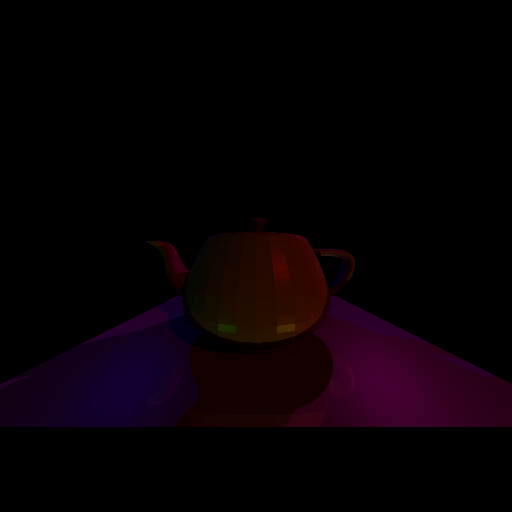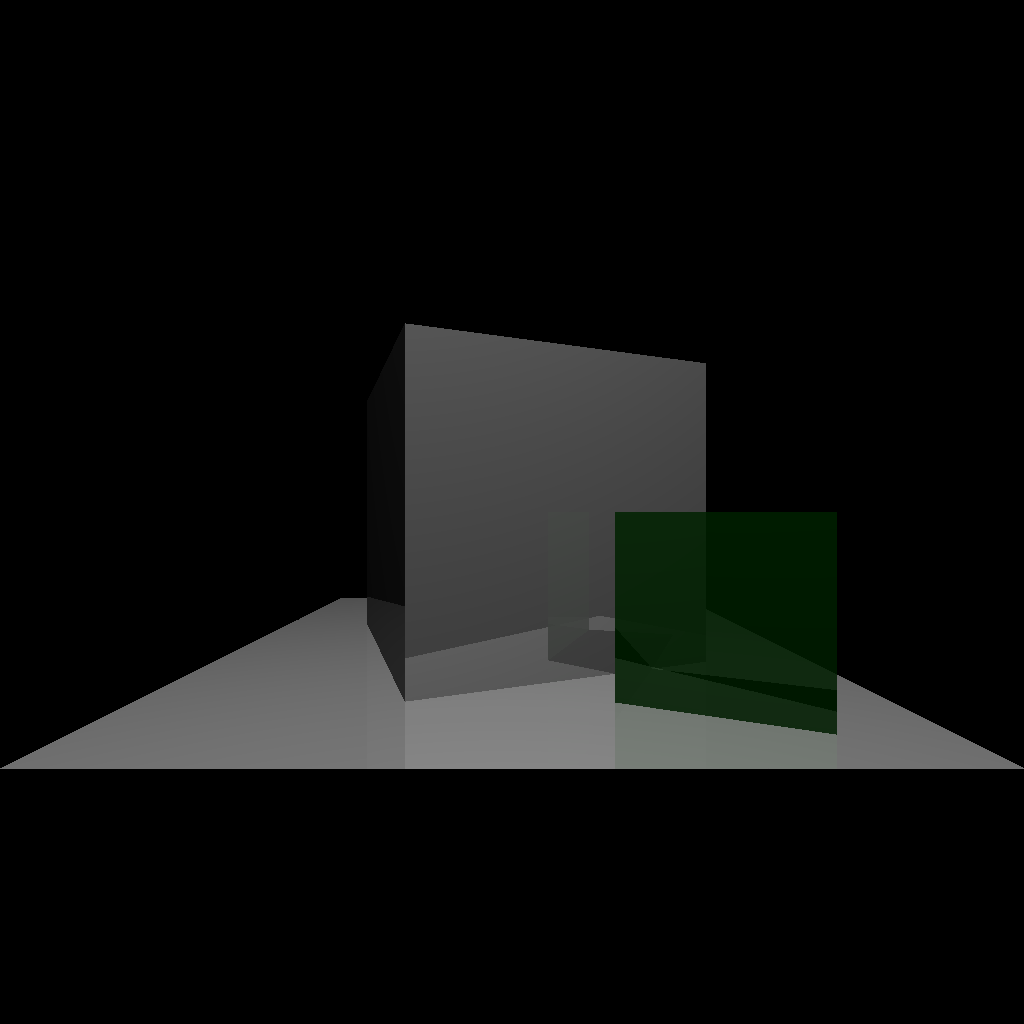|
My first WPF project and I'm kind of diving in the deep end. It'll be a Visual Studio style docking control for WPF. Layout, resizing, window content and tabbing all work now, floating/dragging and pinning are next.code: (The window tabs will looks cooler when it's done)
|
|
|
|

|
| # ¿ Apr 27, 2024 09:36 |
|
UraniumAnchor posted:Yeah, yeah, babby's first raytracer, but I wrote the core in python and then turned the matrix math into a C module (making it about 10x faster), so it's a learning experience for multiple reasons.  Finally got the k-d tree working yesterday, so I implemented triangle meshes today. Total render time, about 20 seconds (with 8 cores) with the k-d tree on and (judging by how slow it is when I run it) about 2 hours with them off. It also uses an embedded Lua interpreter with bindings to my scene objects instead of parsing scene files so I can do things like generate geometry on the fly (see: the ring of spheres).
|
|
|
|
piratepilates posted:This book should just about keep you covered with rendering systems for a few months, pretty much every beginner and some slightly more advanced topics explained and then code provided. It is a monster of a book and I love it. I wrote a raytracer for a graphics class last year, using Lua to define scenes. I used the Physically Based Rendering book for inspiration (and I adapted their kd-tree implementation) but most of the ray tracing algorithms are the usual simplistic ones found online. 
|
|
|
|
My raytracer doesn't read normal info from the obj file (in fact it will break if the obj file has anything other than vertex and face info), and calculates the normal for each face itself. I believe the reason for the seam in my render at least is that there are actually two sets of overlapping vertices at that point, rather than the adjoining faces sharing the same vertices. Thus, the vertex normals along the seam only take into account the face normals of one side of the seam and not the other.
|
|
|
|
Pseudo-God posted:I have slowly been working on a chess game for Windows 8 Metro; I am close to finishing the game logic. Some artwork has also been finished. I am proud of the chess pieces I designed, they are modern but recognizable: I don't think the king and queen are distinguishable enough from each other. The defining characteristic of the king is usually the cross on top and the queen's is the spiky crown. They both look like queens to me.
|
|
|
|
The only way I can even function in a game of computer chess is with the standard 2D pictograms. I can't play on a 3D rendering of a chess board, and I can't play with weirdo reinterpretations of the pieces. It affects the way I perceive the board. The standard chess icons have been around since the 19th century at least, so why change them?
|
|
|
|
steckles posted:More ray tracer images hooray! For example, the spheres in this scene were added with a simple loop inside the scene file.  It was a pretty rudimentary implementation because I was under severe time pressure, but I think that embedding a proper scripting language is a pretty good way to solve the file format problem and also make the language much more powerful than it would be otherwise. A simple scene might look like this: Lua code:
|
|
|
|
SlightlyMadman posted:Just disable paste so you make those little shits type it in because that's the only way you'll learn.
|
|
|
|
I think I'd like the 3D speech box better if it wasn't for the big fat wedge on it. What about having the speech bubble attached to the character doing the talking by a thin spline curve (like a balloon attached by a string)?
|
|
|
|
Is it really necessary to have more than two levels of granularity? Why not just have a second bar of the same size pop out of the side when it's activated, like a fine tuning knob on a radio. It doesn't look like any of those values have significant enough precision to justify such complicated input methods.
|
|
|
|
duck pond posted:I set up the arbitrary-precision dial like I was talking about. edit: Although it's hard to translate to the physical model but still having to move half a screen away from the dial to make fine steps is going to be a hassle, plus it makes it easy to wildly mess up your settings by accidentally moving the dial slightly.
|
|
|
|
Another obvious problem -- what happens when the knob is on the left edge of the screen and turned down all the way? You won't be able to use it properly.
|
|
|
|
Bahama.Llama posted:I discovered LaTeX in this thread thanks to the beaglesnes, and holy poo poo... it is awesome. I've found myself making documents for projects at work and they are in a much nicer format even without using the fancy templates. If you haven't taken a stab, don't be afraid of the initial work - It really is easier than MS Word.
|
|
|
|
Not a screenshot since it's just a library, but I found myself needing to test fairly complex JSON responses in a Python web application, and drilling down into a tree that may contain lists of trees or whatever gets hairy, so I made a little structural matching library. I have no idea if something like this already exists but I couldn't find it. It can be used to match any kind of object but the most interesting part is the Tree pattern which lets me match dict-like objects against tree strutures. For example: code:code:I'm thinking of cleaning it up and making it into a real package if it seems useful.
|
|
|
|
I've actually integrated the above into my unit tests now and it works really well.code:Volte fucked around with this message at 00:19 on Nov 12, 2014 |
|
|
|
I am writing my master's thesis in LaTeX and I need to typeset both Haskell and Scala code inline in the document, literate style. Normally Haskell is handled by lhs2tex, but it's extremely old and kind of lovely, and is a bitch to integrate into your main document if you only need a few pages typeset. So I spent two days porting the useful functionality of lhs2tex (which is only a very small part of it, turns out) to Python and integrating it with pygments to make it handle any language rather than just Haskell. It also simply processes text so you can process two paragraphs out of your whole document, rather than producing a full separate TeX document. The desirability of non-monospaced typesetting of code may be controversial but I thought it was an interesting pursuit anyway and I'm pretty happy with the result.  The important feature is the column-based alignment from lhs2tex. It's not as fine-tuned as lhs2tex but I'm just going to tweak it ad-hoc to fit my needs as I write my thesis. The Scala part mostly works but I haven't written a token spacing algorithm for it yet so everything is all mushed togther (other than the column-based alignment).  I dunno why that object keyword is not highlighted, pygments knows about it---I checked. Volte fucked around with this message at 13:37 on Aug 24, 2015 |
|
|
|

|
| # ¿ Apr 27, 2024 09:36 |
|
Well that's satisfying. Still have to tweak some of the symbol replacements and spacing and stuff, but now I can get back to writing.
|
|
|









